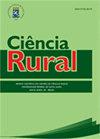巴西帕拉纳西南部橄榄园橄榄叶蛾时空分布及生物杀虫剂防治
IF 0.9
4区 农林科学
Q3 AGRONOMY
引用次数: 0
摘要
摘要/ ABSTRACT摘要:对橄榄叶蛾(Palpita forficera Munroe, 1959)在橄榄栽培潜力新区的时空分布进行了调查,并评价了生物杀虫剂对橄榄叶蛾的防治效果。由Koroneiki和Arbequina品种组成的实验果园种植在巴西帕拉帕本文章由计算机程序翻译,如有差异,请以英文原文为准。
Spatial and temporal distribution and bioinsecticides control of olive leaf moth in an olive orchard in Southwest of Paraná, Brazil
ABSTRACT: We verified the spatial and temporal distribution of the olive leaf moth (Palpita forficifera Munroe, 1959) in a new potential region for olive cultivation and evaluated the bioinsecticides effectiveness to control this pest. The experimental orchard composed by Koroneiki and Arbequina cultivars was planted in Pato Branco, Southwest region of Paraná, Brazil. In the field, larvae counts were performed weekly on 25 plants of each cultivar, for 12 months, to verify the spatial and temporal distribution. Furthermore, in laboratory conditions, second instar larvae of P. forficifera were fed with olive leaves treated with Azadirachta indica oil, Bacillus thuringiensis, Metarhizium anisopliae and Beauveria bassiana, and the effectiveness in the larvae mortality was used to compare four bioinsecticides and control. The P. forficifera larvae occurred mainly during the three summer months, had a host preference for the ‘Arbequina’ (68.9% of total larvae) and occurred at random distribution patterns throughout the orchard. The A. indica oil and B. thuringiensis both caused almost 100% larvae mortality under laboratory conditions.
求助全文
通过发布文献求助,成功后即可免费获取论文全文。
去求助
来源期刊

Ciencia Rural
AGRONOMY-
CiteScore
1.70
自引率
0.00%
发文量
233
审稿时长
2-4 weeks
期刊介绍:
The purpose of Ciência Rural is to publish the results of original research, note and reviews which contribute significantly to knowledge in Agricultural Sciences. Preference will be given to original articles that develop news concepts or experimental approaches and are not merely repositories of scientific data. The decison of acceptance for publication lies with the Editors and is based on the recommendations of Editorial Comission, Area Committee and/ or ad hoc reviewers. The editors and reviewers are external to the institution.
 求助内容:
求助内容: 应助结果提醒方式:
应助结果提醒方式:


